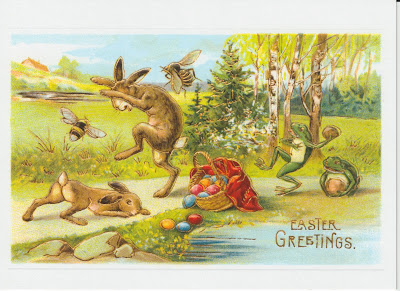Vintage Easter Greeting, ca early 1900s
[Laughing Elephant reproduction]
Happy Easter! With Easter approaching in a few days, I thought I would share theses two reproductions of early 1900s vintage postcards. The cards came from a small local company, Laughing Elephant, that specializes in preserving and reproducing vintage illustrations, books, posters, and artwork.
Both cards feature the Easter Bunny, Easter Rabbit, or Easter Hare of folklore. Much like naughty or nice list made by Santa Claus, the German Lutheran Easter Hare acted as a judge evaluating the behavior children at the beginning of the Easter season. The Hare often carried a basket with colored eggs, candy, and sometimes toys to the homes of children. This legend was first mentioned as a tradition in 1682. Hares or rabbits were a popular motif in medieval church art. They are found in some illuminated manuscripts and paintings associated with the Virgin Mary and the Christ Child. Also when depicted as a threesome they may be associated with the Holy Trinity in something known as the three hare motif.
Eggs have been used as fertility symbols since antiquity. As early as the 1st century AD the egg became an Easter symbol. Since eggs were prohibited during Lent, a common practice was to hand out eggs to children as treats, or sometimes children would go house to house begging for eggs on the Saturday before Lent.
Vintage Easter Greeting postcard, ca early 1900s
[Laughing Elephant reproduction]
Two other symbols connected with Easter can be seen on this card. The frog, who
burrowed under mud during the winter and re-emerged at Spring, represented the Resurrection. And, the honey bee as an emblem of Christ, of his forgiveness through the
sweetness of honey, justice through its sting, and the Christian virtue
because of the way the worker bees behave toward their queen. A traditional Easter candle is made of beeswax.
For additional information, see:
https://en.wikipedia.org/wiki/Easter_Bunny
https://www.history.com/topics/holidays/easter-symbols
https://abiggerworldyet.wordpress.com/2010/04/05/maybe-it-should...
http://websites.umich.edu/~umfandsf/symbolismproject/symbolism.html/B/bee.html


No comments:
Post a Comment